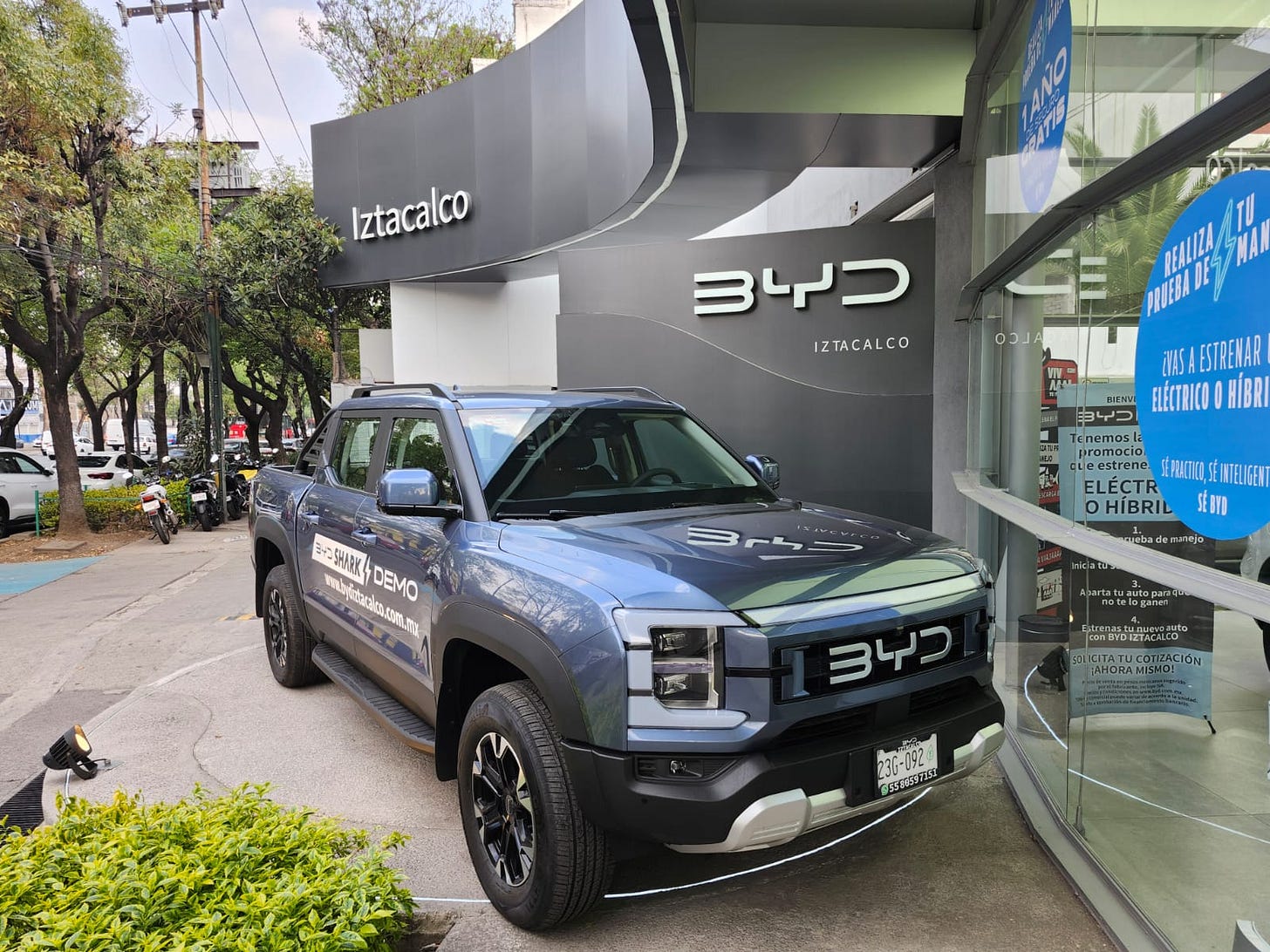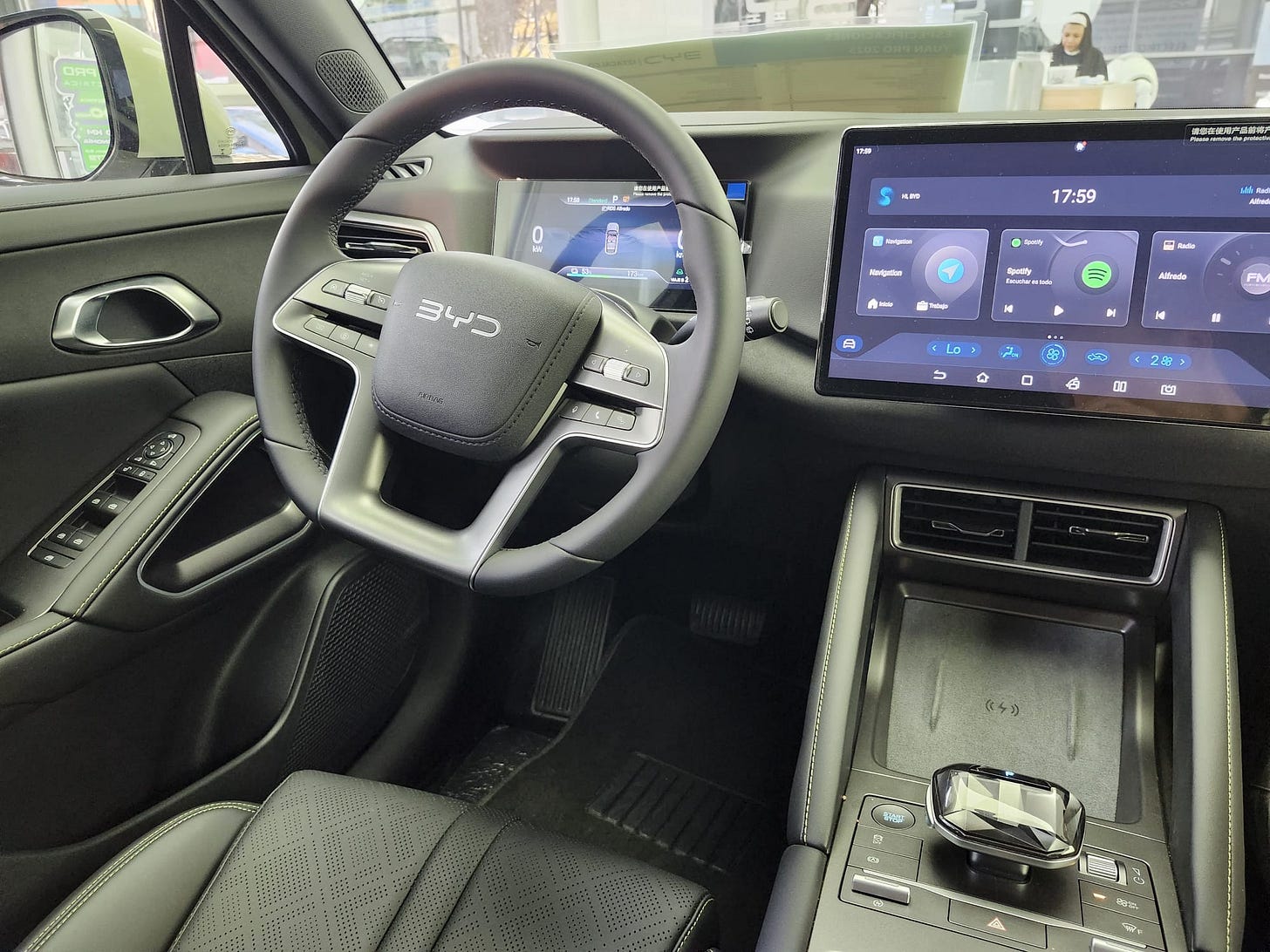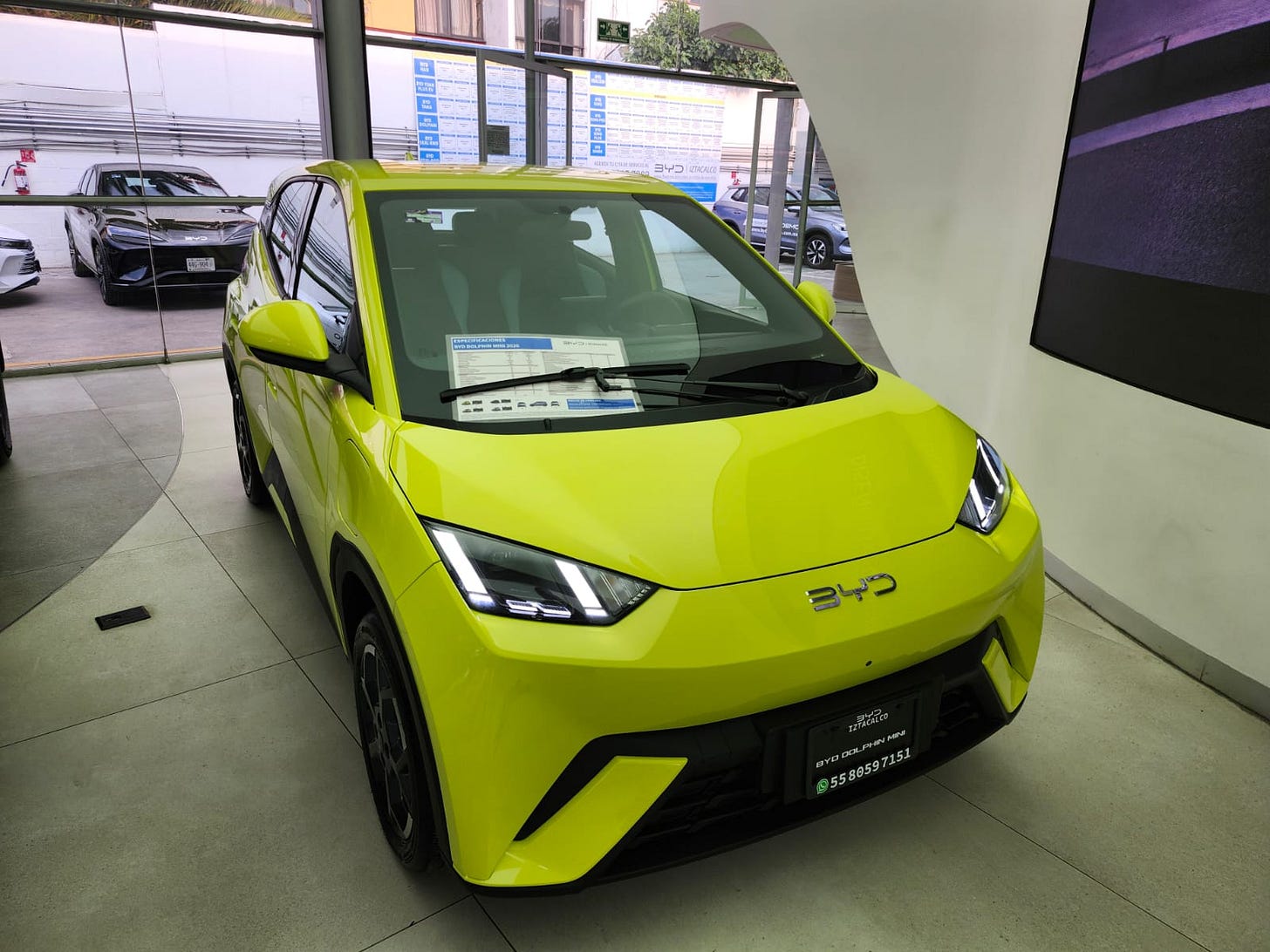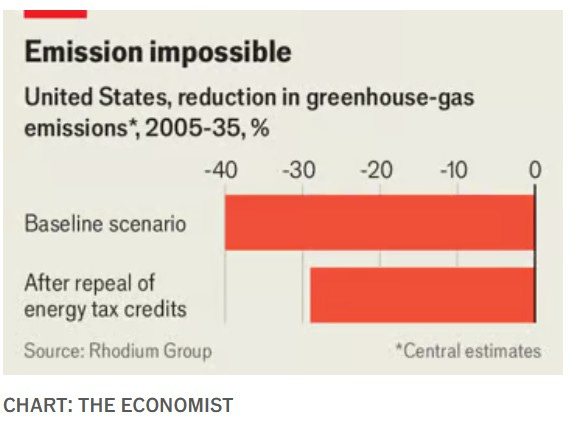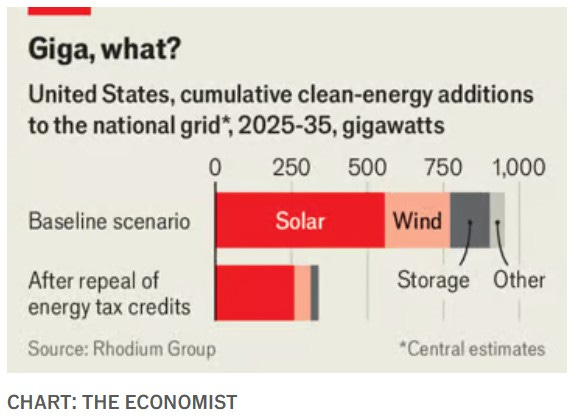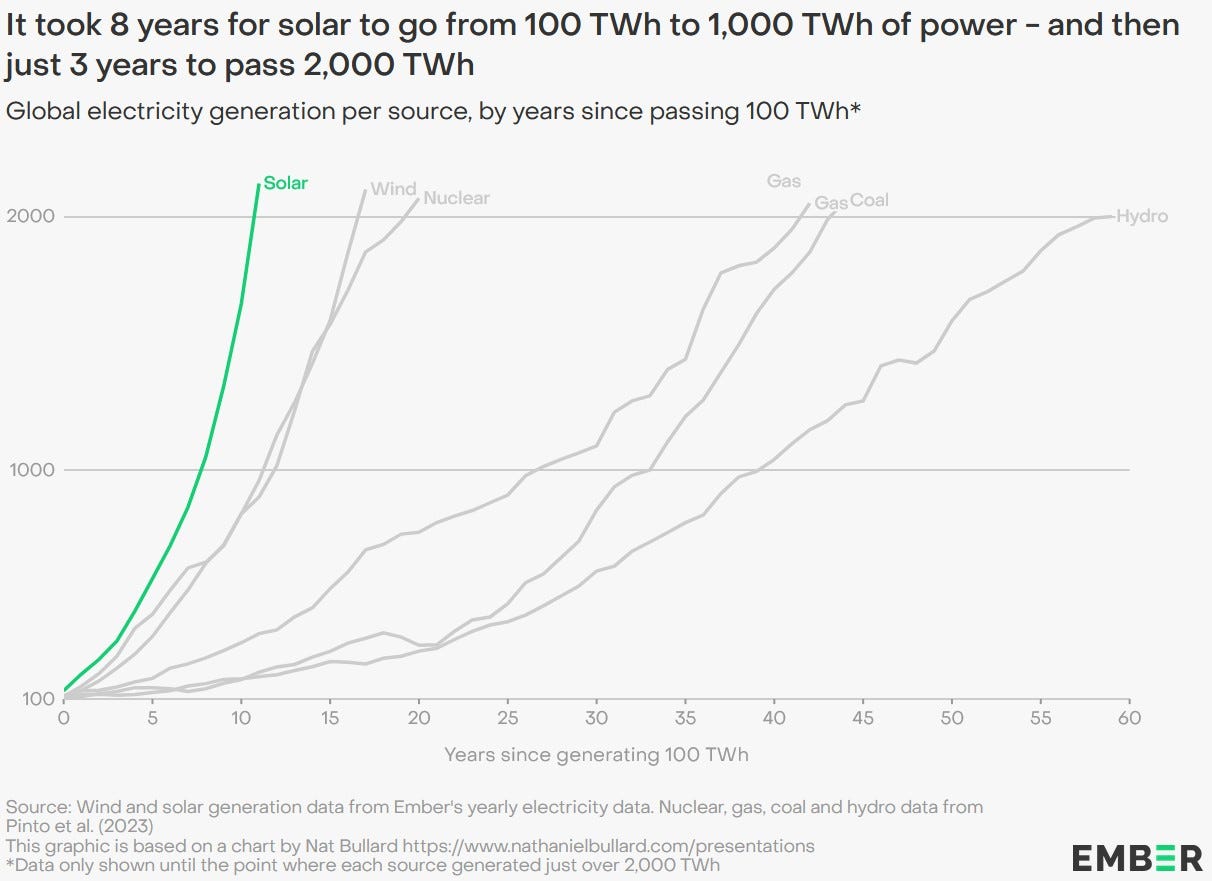Your Daily Dose of Climate Hope: The BYD Dealership of Iztacalco
A dispatch from the fast-electrifying Global South.
This is my fifth article based on in-person reporting from Mesoamerica. I completed that three-month trip in early May 2025, but I’m still writing irregular articles about some of the fascinating people, wildlife, technology, and ecosystems I was lucky enough to see!
On May 2, 2025, I visited the BYD dealership in the Mexico City borough of Iztacalco. This just a few days before the end of my three-month remote-work and reporting journey around Mesoamerica, after starting in Mexico City in January 2025. While writing up this experience in late May 2025, as the U.S. executive branch and Congress endeavor to devastate the nation’s scientific and industrial base with senseless attacks on research funding and clean energy tax credits, this experience has become a bittersweet yet powerful source of hope and optimism for me.
I’m not really a car guy. I’ve driven, but I’ve never owned a personal car: I travel a lot, but almost all on public transport. I had to look up the difference between a hatchback and a sedan for this article, so I’m likely to have missed quite a lot of car-related details. Nevertheless, the BYD dealership of Iztacalco blew me away. I’d read about BYD as the world’s premier EV company and seen the statistics on its impressive technology and accelerating growth (BYD sells to much of the world, but it’s not available in the U.S.), so my expectations were pretty high. They were exceeded.
This dealership was selling thirteen different car models, nine all-electric and four hybrids. Each one was named after a marine animal (the “Ocean Series,” including the Seal, Dolphin, Shark, and Sealion) or a Chinese ruling dynasty (the “Dynasty Series,” including Yuan, Tang, Han, and Song). Most of them featured the cutting-edge Blade lithium iron phosphate battery, some of the most advanced EV tech in the world right now.

During my visit, I got to go inside the showroom demo models of the Shark (a hybrid pickup truck) the Song Plus (a hybrid SUV), the Yuan Plus (an all-electric SUV), the Dolphin Mini (an all-electric hatchback), and the Sealion 7 (an all-electric family car).
Everything about the BYD dealership seemed designed to give off an air of elegant techno-luxury. A giant screen boasted of BYD’s new Lingyuan car-mounted drone launching and recharging system (currently only available in China). The cars’ gear shifts were faceted so they looked like immense jewels.
The BYD Yuan Pro advertised its 100%-electric drivetrain and in-car karaoke setup. (The Guardian’s recent article on BYD’s integration of karaoke into their cars was titled “Sing when you’re winning”). All the cars had comfortable seats, ice-cold air conditioning, and preloaded Spotify linked to integrated in-car sound systems.
In the Sealion 7, I tapped the central console’s integrated touchscreen to get a live readout of the particulate matter (PM 2.5) air pollution levels both inside and outside the vehicle.
Outside the cars, the dealership’s brightly lit, smoothly curved, shades of off-white interior design made it feel like a giant Apple store. The minimalist elegance of the showcase for genuinely boggling technological advancement felt like what I would have expected from a recent alternate history in which Apple’s “iCar” project had, instead of being canceled, become a wild success and taken the world by storm in the way that the iPod, iPhone, and iPad did. The aesthetic of digital modernity pioneered in 2000s America has gone global, and it’s now adorning shops for technologies that have never seen U.S. soil.
The BYD Dolphin Mini was the cheapest model available at the dealership when I went there. The information page tucked under the windshield wiper informed me that they were selling a brand-new BYD Dolphin Mini for 399,800 Mexican pesos, after tax. At May 2025 exchange rates, that cost equates between $20,000 and $21,000 U.S. dollars.
And this is BYD’s cheapest car price in Mexico City, but it isn’t BYD’s cheapest price in the world — not by a long shot. The Dolphin Mini is another name for the Seagull, BYD’s smallest and cheapest model of car. In China, one BYD Seagull now sells for about $8,000 U.S. dollars, or £6,000 UK pounds.
Notably, the higher price in Latin America includes Pacific-crossing transport costs. BYD operates its own vertically integrated seagoing fleet of cutting edge (relatively low-emission!) roll on/roll off vehicle transport ships and recently launched their sixth car-carrying vessel, the Xi’an, with many more on the way.
For context, the average price of a new car in the United States in May 2025 was nearly $50,000 U.S. dollars, and that’s likely to get much, much higher very soon due to tariff chaos and the now-extremely-probable repeal of EV manufacturing tax credits.
One of the unspoken baseline assumptions of growing up in the United States is that our country has the best stuff. Sure, maybe other countries might have older historic monuments, more authentic cultures, more walkable city centers, and someone of a liberal bent might even acknowledge that many other countries have substantially better healthcare and education systems, but I would bet that almost everyone in America believes at some level that when it comes to material goods, especially anything with wheels or a screen, it’s an article of faith that the best version of it will be sold by an American company.
That’s really, really, really, no longer true for cars — one of the biggest and most iconic categories of “material good” on the planet. Someone in Macau or Mexico City now can buy a better, cheaper, cleaner car that is literally impossible to buy at a dealership in Philadelphia or Phoenix.

And those cars are more and more widely available. As of early 2025, China’s electric cars accounted for 62% of the total worldwide EV market, 70% of the total EV market in Mexico, 75% in Indonesia, 77% in Thailand, and 82% in Brazil. Notably, a lot of the countries where China has established early market dominance are selling relatively few EVs right now, but have large populations, meaning they have the potential to absorb a lot more. Indonesia’s EV market amounted to just 43,000 cars in February 2025, but Indonesia is home to over 280 million (280,000,000) people, and it’s developing fast — there’s a lot of room to grow. And BYD intends to fill that space by providing an ever-growing quantity of cheap, clean, and luxurious cars. They’re currently building a new EV factory (and employee housing) complex in Zhengzhou that will has been reported to be larger than the U.S. city of San Francisco, set to produce one million cars per year. I suspect there will be more built soon.
And as data scientist Dr. Hannah Ritchie discussed in a recent article, China’s cleantech advantage isn’t really due to cheap labor anymore — or even Uyghur forced labor (which remains a horrible, unacceptable atrocity). China simply has unprecedentedly high-level and high-quality automation integrated into its solar, battery, and EV manufacturing processes, leading to some of the lowest-cost final products in the world. “Labour costs from BYD are lower, not because of much poorer salaries, but because of high levels of automation. BYD factories can have as few as 50 workers per gigawatt-hour (GWh) of production, compared to as many as 233 workers elsewhere…Leading manufacturers have these high yields because they’ve developed extremely state-of-the-art, optimised production processes with minimal mistakes.”
The contrast between the relentless optimization of BYD and the recent trajectory of Tesla, still arguably America’s leading EV company and until recently the world’s leading EV company as well, is particularly striking. Bill McKibben perhaps put it best in a recent Substack article: “BYD did not waste its time giving Nazi salutes. It didn’t buy a social media platform so it could make obscure marijuana jokes and make fun of poor people. It didn’t devote itself to helping a nincompoop win the presidency and then decide it would be exhilarating fun to fire a bunch of government workers. Instead, BYD did, you know, engineering.”
As Akshat Rathi discussed in depth in his excellent Climate Capitalism book, China has been investing heavily in EV development ever since little-known but historically pivotal engineer Wan Gang gave a farsighted and very convincing presentation to Chinese Communist Party leadership in the year 2000.
China is winning, essentially, on the merits — because they made smarter plans and followed through on them.
EV investment has paid off massively, and China’s leadership has learned from this. World-leading EVs are likely just the beginning. China’s industrial-commercial-scientific research and development is, as of 2025, the envy of the world, and the wave of Chinese cleantech products is likely just getting started.
A recent report from leading energy think tank Ember estimated that nearly 60% of Chinese clean energy technologies were at the concept, prototype, or demonstration stage and had not yet made it to market. In my newsletter, I’ve written about some of the early prototypes in China that could scale up to BYD-level in the upcoming years, and there’s a lot of amazing stuff being developed: grid-scale sodium-ion batteries, ultra-efficient perovskite solar panels, vortex-lance flash ironmaking, eVTOL flying taxis, fully electric humanoid robots, and thorium molten salt reactors, to name just a few that are already being publicly discussed. Any or all of these could join regular solar panels and electric cars as a major Chinese cleantech export that rapidly transforms the Global South — and as much of the Global North as will allow it to be sold in their territory.
The good news for democratic developed nations is that it’s a lot easier to learn how to build something that someone else is already building than to learn how to build something that no one has ever built. And if there’s another country making lots of cool advanced tech, they probably want to sell it to you, which means there’s an obvious “market access for tech information” deal to be made. This is a tried and true development strategy (“you can sell us your cool tech if you also teach us how to build it!”) that China itself used with great success for decades (along with mass IP theft, another classic development technique) and the European Union is already adopting it as a strategy for domestic automaking in the Chinese-dominance era. To quote from an excellent recent Financial Times article, “Volkswagen, Mercedes-Benz, Stellantis and BMW have all signed agreements with Chinese groups to get access to technology…the [EU] commission is looking to require Chinese companies entering the EU car market to enter joint ventures with European companies or license parts of their technology.” India is also pursuing several joint ventures with Chinese EV-makers as it tries to build up its own domestic cleantech industries.
As manifestly hyper-improbable as it is under the current administration, geopolitical commentator Thomas Friedman recommended that the U.S. adopt the same tactics in his recent New York Times column “I Just Saw the Future. It Was Not in America.” He advocates for a policy of “Made in America, by American Workers, in Partnership With Chinese Capital, Technology and Experts. That is, we just reverse the strategy China used to get wealthy in the 1990s, which was: Made in China, by Chinese Workers, With American, European, Korean and Japanese Capital, Technology and Partners….We should be combining any tariffs on China with a welcome mat for Chinese companies to enter the U.S. market by licensing their best manufacturing innovations to U.S. firms or by partnering with them and creating advanced manufacturing factories in 50-50 ventures.”
But as you may have noticed if you’ve read the news recently….pretty much the exact opposite of that has happened. The Republican-dominated U.S. House of Representatives recently passed what is potentially the worst piece of legislation in modern American history, a federal budget that among many other bad things will remove the Inflation Reduction Act’s clean energy tax credits, add burdensome red tape to hobble renewables development, cut benefits and lower taxes to redistribute wealth from the poorest Americans to the richest Americans, and continue the current administration’s wilful destruction of America’s once-leading governmental scientific research efforts. Analyses indicate that it will likely raise electricity costs, slow emissions reductions, and slow electricity capacity build-outs substantially. It’s genuinely painful to even read the details - it’s about as bad as such a bill could be.
Before being signed into law, this nightmare still has to pass the Senate, and then the Senate version has to pass the House again, which will likely take at least until July and possibly until August. It may get a bit better in that process, and every inch of ground in this struggle is worth fighting for, but the direction of travel is clear: we’re going to end up with something on the spectrum between “horrific damage” and “really extremely terrible horrific damage.”
Under Biden, China was already outpacing the U.S. in the global “race” to develop and market clean energy technologies, but the U.S. was at least still trying to run, chugging some IRA tax credit “energy drinks” and measurably speeding up.
Under Trump, China’s running even faster and starting to think about what lap to start its upcoming sprints, while the U.S. has sat down on the grassy margins of the racetrack and is currently debating how much of its own legs to saw off.
As an American…we are so getting our butts kicked, and it’s painful to read about. This bill pretty much hands global technological leadership to China on a plate.
But as a human, China’s surge of clean energy innovation is still spectacular news for civilization and the planetary biosphere, and it’s even more important now that the U.S. has entered this frenzy of self-sabotage. Global progress on climate change and electrification will continue zooming ahead, in large part thanks to Chinese R&D. In an alternate history where China had never embraced market-economy reforms under Deng Xiaoping and was still a Mao-esque “giant-size North Korea,” the world’s chances of fighting against climate change and transitioning to clean energy would look a heck of a lot worse. In a no-Chinese-cleantech world, the repeal of innovation-boosting clean energy tax credits in the U.S. would be a global catastrophe. Now, it’s a regional setback.
Maybe the U.S. will get back in the race for cutting-edge cleantech for real in 2029. China gaining a world-dominating share of the fast-growing electric car market clearly wasn’t enough to trigger a “Sputnik moment” for America (the U.S. response based on the recent House Republican budget is as if we’d said in response to Sputnik “space seems like a Soviet thing, might as well not try!”), but maybe literal made-in-China flying cars and humanoid robots, arriving as soon as next year, will finally wake up Republican policymakers to the importance of investing in battery industries.
On the bright side, although the U.S. will be dramatically less globally competitive for no reason other than ideological nonsense and that really sucks, analyses of this bill’s impact do indicate that the U.S. will still be moving towards lower emissions and cleaner electricity, no matter how desperate the attempts to prop up fossil fuels become. New capacity additions to the U.S. grid have been over 96% clean energy for over a year now — this bill won’t switch that back to fossil fuels, it’ll just lower the total amount of all new electricity-generating sources being built in America. Which is bad on a number of levels — we BADLY need an Abundance Agenda to make it easy to build out plentiful clean power! But there’s no fossil fuel resurgence in sight.
According to The Economist’s excellent summary of Rhodium Group analysis, the U.S. was on track for a reduction of greenhouse gas emissions by 40% from 2005 to 2035 thanks to the Inflation Reduction Act. After this self-sabotaging budget, it’ll likely be a bit under a 30% reduction by 2035.
This bill will likely reduce clean energy build-out across America from nearly 1,000 gigawatts (GW) by 2035 to around 342 GW by 2035. That’s extremely painful. That’ll mean higher electricity prices just about everywhere, and make it harder to build and power green steel, batteries, cars, AI data centers, and lots of other things. America is making the choice to become a laggard, not a leader — a de-industrializing state that’s falling behind on one of the core drivers of economic development in the 21st century.
There will be opportunities to bounce back. America has a lot of smart and driven people, and the ever-improving underlying economics of clean energy will incentivize further innovation even with an actively hostile government. I very much hope that promising American cleantech projects (e.g. First Solar’s domestic tandem PV manufacturing, Slate Auto’s planned cheap electric pickup truck, advanced geothermal startups like Fervo and Sage, Lonnie Johnson’s all-solid-state batteries, and General Motors’ LMR batteries) manage to survive and grow even during the likely upcoming post-IRA “lean years,” perhaps aided by pro-abundance policies at the state level. I’ll do my best to try to help make this happen with my writing.
But while the U.S. struggles, the rest of the world is still accelerating. Solar power just keeps on growing faster than any other energy source ever has. The headlines in solar-industry news sites these days would have seemed like a climate activist’s utopian fantasy ten years ago. Solar factories are going up from Oman to Ethiopia. Solar imports in the first half of 2024 alone absolutely transformed the energy system of Pakistan, and the fans and ACs they power will likely solve multitudes of lives during the next South Asian heatwave. China’s solar growth looks to have caused an emissions peak in the world’s biggest emitter years before it was expected. Sub-Saharan Africa might be seeing the beginning of an exponential solar boom. Solar mini-grids are empowering remote indigenous villages across Latin America. Researchers are finding that the fast-expanding solar farms in deserts actually benefit local wildlife by providing shade and a windbreak.
The forces of reason, science, sanity, and progress may be losing some engagements in the Battle for America, but are looking more likely than ever to win World War Climate. Human civilization will transition to clean energy faster than almost anyone thought possible. Families across South and Southeast Asia and sub-Saharan Africa will go straight from “no electricity” to “abundant clean electricity,” skipping the fossil fuel age entirely. Megacities across the Global South will skip past decades of horrible lifespan-stealing air pollution thanks to rapid deployment of electric cars and solar farms. I personally wouldn’t be surprised if global carbon emissions are in free fall by the 2030s, well ahead of even highly optimistic projections, as cleantech continues to outperform expectations and ends up dominating essentially all market segments that formerly burned fossil fuels. Viewed from 2025, it looks like Earth in 2035 and 2045 will be a much healthier, cleaner, more electrified place than it looked like it was going to become as of 2015.
And that bright future, as of right now, looks like it will be primarily made in China.




